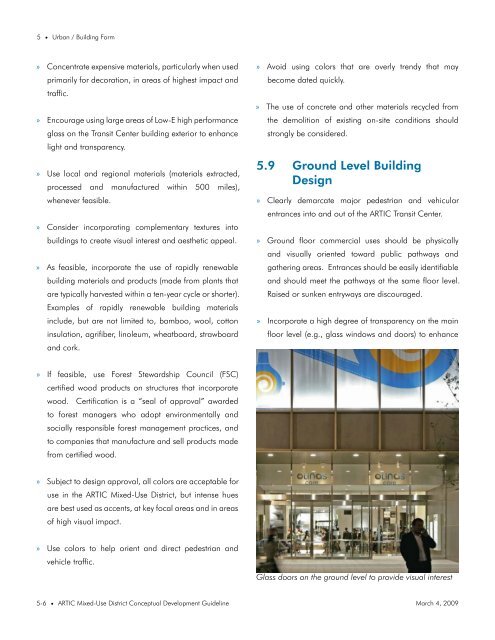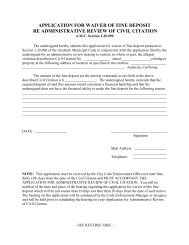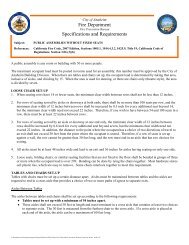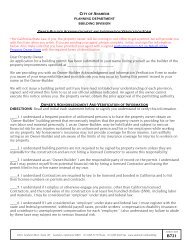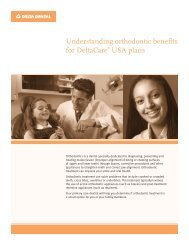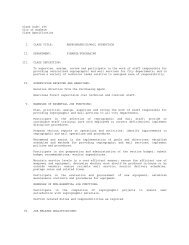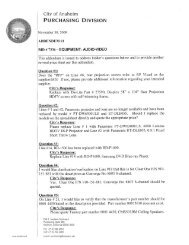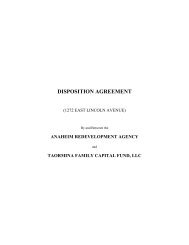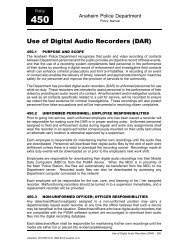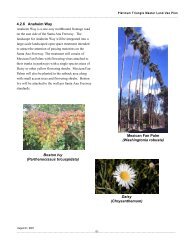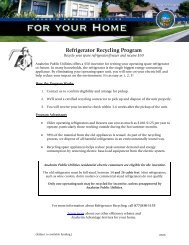ARTIC Mixed-Use District Conceptual ... - City of Anaheim
ARTIC Mixed-Use District Conceptual ... - City of Anaheim
ARTIC Mixed-Use District Conceptual ... - City of Anaheim
You also want an ePaper? Increase the reach of your titles
YUMPU automatically turns print PDFs into web optimized ePapers that Google loves.
5 • Urban / Building Form<br />
»<br />
»<br />
»<br />
»<br />
»<br />
»<br />
»<br />
»<br />
Concentrate expensive materials, particularly when used<br />
primarily for decoration, in areas <strong>of</strong> highest impact and<br />
traffic.<br />
Encourage using large areas <strong>of</strong> Low-E high performance<br />
glass on the Transit Center building exterior to enhance<br />
light and transparency.<br />
<strong>Use</strong> local and regional materials (materials extracted,<br />
processed and manufactured within 500 miles),<br />
whenever feasible.<br />
Consider incorporating complementary textures into<br />
buildings to create visual interest and aesthetic appeal.<br />
As feasible, incorporate the use <strong>of</strong> rapidly renewable<br />
building materials and products (made from plants that<br />
are typically harvested within a ten-year cycle or shorter).<br />
Examples <strong>of</strong> rapidly renewable building materials<br />
include, but are not limited to, bamboo, wool, cotton<br />
insulation, agrifiber, linoleum, wheatboard, strawboard<br />
and cork.<br />
If feasible, use Forest Stewardship Council (FSC)<br />
certified wood products on structures that incorporate<br />
wood. Certification is a “seal <strong>of</strong> approval” awarded<br />
to forest managers who adopt environmentally and<br />
socially responsible forest management practices, and<br />
to companies that manufacture and sell products made<br />
from certified wood.<br />
Subject to design approval, all colors are acceptable for<br />
use in the <strong>ARTIC</strong> <strong>Mixed</strong>-<strong>Use</strong> <strong>District</strong>, but intense hues<br />
are best used as accents, at key focal areas and in areas<br />
<strong>of</strong> high visual impact.<br />
<strong>Use</strong> colors to help orient and direct pedestrian and<br />
vehicle traffic.<br />
5-6 • <strong>ARTIC</strong> <strong>Mixed</strong>-<strong>Use</strong> <strong>District</strong> <strong>Conceptual</strong> Development Guideline<br />
»<br />
»<br />
Avoid using colors that are overly trendy that may<br />
become dated quickly.<br />
The use <strong>of</strong> concrete and other materials recycled from<br />
the demolition <strong>of</strong> existing on-site conditions should<br />
strongly be considered.<br />
5.9 Ground Level Building<br />
Design<br />
»<br />
»<br />
»<br />
Clearly demarcate major pedestrian and vehicular<br />
entrances into and out <strong>of</strong> the <strong>ARTIC</strong> Transit Center.<br />
Ground floor commercial uses should be physically<br />
and visually oriented toward public pathways and<br />
gathering areas. Entrances should be easily identifiable<br />
and should meet the pathways at the same floor level.<br />
Raised or sunken entryways are discouraged.<br />
Incorporate a high degree <strong>of</strong> transparency on the main<br />
floor level (e.g., glass windows and doors) to enhance<br />
Glass doors on the ground level to provide visual interest<br />
March 4, 2009


